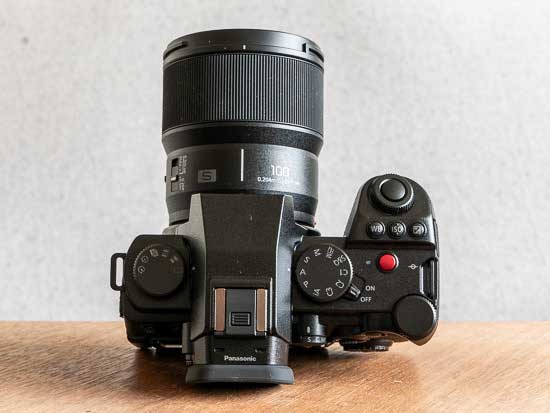
Introduction
The Panasonic Lumix S 100mm F2.8 Macro is a mid-telephoto macro prime lens for L-Mount (Panasonic, Sigma, Leica) full-frame mirrorless cameras.
It can also be used with APS-C sensor models where it provides an equivalent focal length of 150mm.
It offers a minimum focusing distance of 20.4cm / 0.669ft with a life-size maximum magnification ratio of 1:1.
This is a very compact and lightweight macro lens, yet it still offers a bright maximum aperture of F2.8 for better low-light performance and bokeh effects.
It is officially the world’s smallest and lightest medium-telephoto fixed focal length macro lens with a magnification ratio of 1:1 and a focal length of 90mm or more.
It features 13 elements in 11 groups including 3 aspherical lenses, 2 UED lenses and 1 ED lens and a 9 blade diaphragm which creates an attractive blur to the out-of-focus areas of the image.
A newly developed Dual Phase Linear Motor promises to deliver fast and precise autofocus performance with excellent moving subject tracking and silent focusing.
The Panasonic Lumix S 100mm F2.8 Macro lens will be available at the end of January 2024 priced at £999 / €1099 in the UK and Europe, respectively.
Ease of Use

Weighing in at 298g / 0.66lb and measuring 82.0mm / 3.23inch in length, the Panasonic Lumix S 100mm F2.8 Macro is much lighter and smaller than any of its main rivals, which include the Sigma 105mm F2.8 DG DN MACRO Art and the Laowa 100mm f/2.8 2:1 Ultra Macro APO.
It’s compact size makes it feel very well balanced on a mid-sized camera body like the Lumix S5 IIX body that we tested it with, as shown in the product photos.


Build quality is very good. The Lumix S 100mm F2.8 Macro feels solid in your hand, even if it is mostly made out of plastic, with a metal lens mount.
It’s also weather-proof, being both dust and splash resistant and working all the way down to -10 degrees. We successfully used it in a heavy shower with no adverse effects.


There is no built-in Image Stabilisation, though, with the lens instead relying on the camera body’s stabilisation system (if it has one).
The Panasonic Lumix S 100mm F2.8 lens has a generously wide focus ring with a ridged, rubberised grip band.
There are no hard stops at both ends of the range, making it more difficult to set focus at infinity.
Polariser users should be pleased that the 67mm filter thread doesn’t rotate on focus.


In terms of controls, there are just two switches in addition to the focusing ring.
Firstly, there’s a focus mode switch with the standard AF/MF settings.
Secondly, there’s a focus range limiter switch that helps prevent the lens from hunting through the entire focusing range. There are three options – Full, infinity to 0.5m, and 0.204 to 0.5m.


When it comes to auto-focusing, the Lumix S 100mm F2.8 is a quick performer for a macro lens, taking around 0.10 seconds to lock onto the subject when mounted on the Panasonic S5 IIX camera that we tested it with.
We didn’t experience too much “hunting”, either in good or bad light, with the lens accurately focusing virtually all of the time in the single AF-S mode.


The Dual Phase Linear Motor focusing mechanism is very quiet, in fact virtually silent, making this lens well-suited to video recording as well as candid stills photography.
In terms of accessories, this lens is supplied with a good quality circular plastic round lens hood which locks into place when fully engaged.




Focal Range
The Panasonic Lumix S 100mm F2.8 Macro’s focal length of 100mm provides an angle of view of 24°.

Chromatic Aberrations
Chromatic aberrations, typically seen as blue or purple fringes along contrasty edges, were not that apparent in our test shots, only appearing in very high contrast areas.

Vignetting
With the lens set to its maximum aperture of f/2.8, there is some obvious light fall-off in the corners, requiring you to stop down by at least 2 f-stops to prevent it.

Distortion
There’s some very slight barrel distortion evident in the RAW files – the S5 IIX camera automatically and successfully applies corrections to the JPEG files.


Macro
The Panasonic Lumix S 100mm F2.8 Macro offers a very useful minimum focusing distance of just 20.4cm / 8.03″, with a maximum magnification of 1.0x.





Bokeh
Bokeh is a word used for the out-of-focus areas of a photograph, and is usually described in qualitative terms, such as smooth / creamy / harsh etc.
In the S 100mm F2.8 Macro lens, Panasonic have employed an iris diaphragm with 9 rounded blades, which has resulted in very nice bokeh in our view.
We do realise, however, that bokeh evaluation is subjective, so we’ve included lots of examples below for your perusal.







Sharpness
In order to show you how sharp the Panasonic Lumix S 100mm F2.8 Macro lens is, we are providing 100% crops on the following page.
Credit : Source Post






